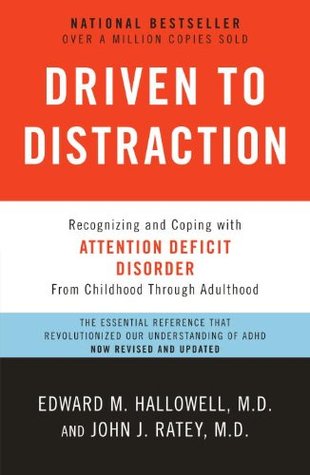More on this book
Community
Kindle Notes & Highlights
harangued
etiology
ADD is a neurological syndrome whose classic defining triad of symptoms include impulsivity, distractibility, and hyperactivity or excess energy.
one bases the diagnosis of ADD not on the mere presence of these symptoms, but on their severity and duration, and the extent to which they interfere with everyday life.
But there is another kind of ADD that shows no hyperactivity whatsoever. Indeed, these people can be underactive. This is the child, often a girl, who sits at the back of the classroom daydreaming, or the adult who moves serenely within a cloud, never quite present anywhere.
but they can also be unusually empathic, intuitive, and compassionate, as if in that tangled brain circuitry there is a special capacity to see into people and situations.
it’s sort of like being nearsighted. You don’t focus very well. You have to strain to see clearly. People with ADD have trouble attending to one task at a time.
The hallmark symptoms of ADD are easy distractibility, impulsivity, and sometimes, but not always, hyperactivity or excess energy.
These people are on the go. Type A personalities. Thrill seekers. High-energy–, action-oriented–, bottom-line–, gotta-run–type people. They have lots of projects going simultaneously. They’re always scrambling. They procrastinate a lot and they have trouble finishing things. Their moods can be quite unstable, going from high to low in the bat of an eye for no apparent reason. They can be irritable, even rageful, especially when interrupted or when making transitions. Their memories are porous. They daydream a lot. They love high-stimulus situations. They love action and novelty.
obstreperous,
sequester
“It is not unusual for people with ADD to have erratic, inconsistent educational histories
“It’s as if a veil has been lifted from Penny’s eyes. She can see us and we can see her. She’s still my dreamer, but now it’s on purpose that she dreams.”
Structure is one of the hallmarks of the treatment of ADD, and the tight forms within which Mozart worked show how beautifully structure can capture the dart-here, dart-there genius of the ADD mind. In fact, there is a powerfully positive aspect to ADD, and learning disorders in general, a positive aspect that is as yet ill defined.
convivial
bonhomie
The themes of ADD run throughout: inconsistency, and inconsistency again, creativity, provocative behavior, winning personality, varying motivation, exasperating forgetfulness, disorganization and indifference, underachievement, impulsivity, and the search for excitement rather than discipline.
deep-seated self-reliance is not uncommon among young males diagnosed with ADD.
gerund
1. A sense of underachievement, of not meeting one’s goals (regardless of how much one has actually accomplished).
2. Difficulty getting organized.
3. Chronic procrastination or trouble getting started.
4. Many projects going simultaneously; trouble with follow-through.
5. Tendency to say what comes to mind without necessarily considering the timing or appropriateness of the remark.
6. A frequent search for high stimulation.
7. An intolerance of boredom.
8. Easy distractibility, trouble focusing attention, tendency to tune out or drift away in the middle of a page or a conversation, often coupled with an ability to hyperfocus at times.
that this is a syndrome not of attention deficit but of attention inconsistency.
9. Often creative, intuitive, highly intelligent.
10. Trouble in going through established channels, following “proper” procedure.
11. Impatient; low tolerance for frustration.
need for constant stimulation and can lead others to think of the individual as immature or insatiable.
15. Mood swings, mood lability, especially when disengaged from a person or a project.
16. Restlessness.
17. Tendency toward addictive behavior.
The addiction may be to a substance such as alcohol or cocaine, or to an activity, such as gambling, or shopping, or eating, or overwork.
19. Inaccurate self-observation.
Family history of ADD
Childhood history of ADD.
An adult history of persistent attentional problems and motor hyperactivity together with two of the following five symptoms: affective lability, hot temper, stress intolerance, disorganization, and impulsivity.
expunged,
I’ve got to be moving in order to think—that’s all there is to it.”
People with ADD also love cars. ADD loves movement. Many adults with ADD report that their best thinking is done while driving. And people with ADD love big cities, all big cities but particularly New York, Las Vegas, and, especially, Los Angeles. ADD might as well have been invented in Los Angeles.
above. For many adults ADD is a subtle but definite part of who they are, like a red thread sewn into a pinstripe suit, changing its look but only visible upon close inspection.
And the treatment may not be to remove the red thread but rather to change its hue only slightly so that it enhances rather than clashes with its surroundings.
She found that by taking medication a half hour prior to doing her writing it went much more smoothly for her. She
made him appear quite self-centered or indifferent.
These are a few of the areas in which mild ADD may interfere with an adult’s life: underachievement; reading one’s interpersonal world accurately; getting started on a creative project, or finishing it; staying with emotions long enough to work them out; getting organized; getting rid of perseverative, negative thinking; slowing down; finding the time to do what one has always wanted to do; or getting a handle on certain compulsive types of behavior.
it’s not guilt. It’s insecurity. A feeling of being a fraud. Not a fraud, really, because I know I’m not deliberately faking anything. It’s as if I woke up one day and I was at this grand ball, but I don’t know how I got there, and I don’t know how I’ll carry it off.”
“I think what you’ve been doing, Laura, is working so hard most of your life to stave off chaos that you’ve developed a habit of doing it with worry. You use one toxic state to stave off another.


